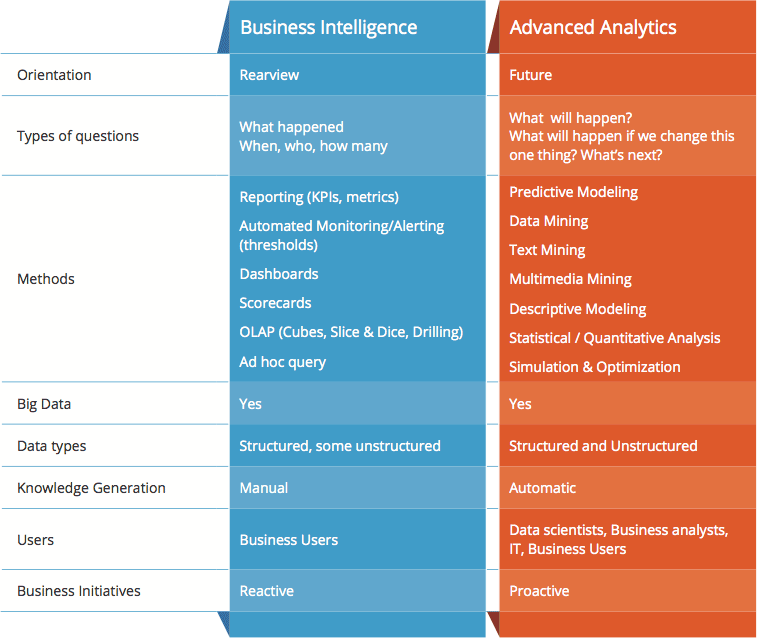What’s the difference between Business Analytics and Business Intelligence? The correct answer is: everybody has an opinion, but nobody knows.
For example, when SAP says “business analytics” instead of “business intelligence”, it’s intended to indicate that business analytics is an umbrella term including data warehousing, business intelligence, enterprise information management, enterprise performance management, analytic applications, and governance, risk, and compliance.
But other vendors (such as SAS) use “business analytics” to indicate some level of vertical/horizontal domain knowledge tied with statistical or predictive analytics.
At the end of the day, there are two things worth differentiating:
- The first is the business aspect of BI — the need to get the most value out of information. This need hasn’t really changed in over fifty years (although the increasing complexity of the world economy means it’s ever harder to deliver). And the majority of real issues that stop us from getting value out of information (information culture, politics, lack of analytic competence, etc.) haven’t changed in decades either.
- The second is the IT aspect of BI — what technology is used to help provide the business need. This obviously does change over time —sometimes radically.
Quick Comparison
We know that Analytics refers to the skills, technologies, applications and practices for continuous iterative exploration and investigation of data to gain insight and drive business planning. Analytics consists of two major areas: Business Intelligence and Business Analytics.
What is often overlooked is how the two differ based on the questions they answer:
- Business Intelligence : traditionally focuses on using a consistent set of metrics to measure past performance and guide business planning. Business Intelligence consists of querying, reporting, OLAP (online analytical processing), and can answer questions including “what happened,” “how many,” and “how often.”
- Business Analytics : goes beyond Business Intelligence by using sophisticated modelling techniques to predict future events or discover patterns which cannot be detected otherwise. Advanced Analytics can answer questions including “why is this happening,” “what if these trends continue,” “what will happen next” (prediction), “what is the best that can happen” (optimization).
The Evolution of Business Intelligence vs Business Analytics
In the past, BI has been used to talk about the people, processes and applications used to access and extrapolate meaning from data, for the sake of improving decisions and understanding the effectiveness of targeted decisions. But this is where BI as a baseline failed; something that runs entirely off of static, historic data severely limits a user’s ability to make predictive decisions and forecast for the future market. When an emergent situation arises on a Friday afternoon, the user doesn’t greatly benefit from looking at metrics collected prior to the introduction of that situation.
The rapid growth and demand for BA comes from this failing, and is in a way the evolved form of BI solutions. In a business world whose speed is ever-increasing, the user needs to be able to interact with information at the speed of business, not looking back over his or her shoulder at what happened in the past. BI setups alone do not support the occurrence of users asking and answering questions in the face of marketplace events as they happen. A company that is data-driven sees their data as a resource, and uses it to hedge out competition. The more current the data the user has, the better jump he or she has on the competitor, who may or may not have become a threat in a time so recent that traditional BI data reporting wouldn’t even take them into consideration.
Many companies are commonly implementing advanced analytics on top of their data warehouses, to bridge the gap between BI and current day needs. Perhaps this is the origin of the confusion between terms, as organizations pick and choose from different combinations of services and have no real understanding of what to call these mashups.
Equally relevant is the fact that more and more people are being asked to interpret data in roles that are not strictly analytical. Product managers, marketers and researchers are moving towards data as a way to formulate strategies, and traditional BI platforms make it difficult to push data into real-time situations and what-if scenarios. With the importance of data-driven decisions increasingly becoming a realization for less tech-savvy branches of company teams, the need for more user-friendly and faster producing platforms also grows. Moreover, delivering the data that supports these decisions to a broader company team demands a more visual form of modeling tool, to improve understanding across all departments. Charts and graphs showing BA findings are quicker and more impacting than written out statistics and excel sheets full of data.
Data interpretation and the manipulation method of choice change as the market demands. While having a set of established methods is important to the effectiveness of a company’s strategy, it’s understanding the need for flexibility in the face of these changes that can be a company’s most valuable asset.
To summarize,
WHAT is happening to your business = Business Intelligence (For Visibility)
WHY it is happening, WHAT WILL likely happen in future = Business Analytics (For Investigation, Prediction & Prescription).
References:
- https://www.quora.com/What-is-the-difference-between-business-intelligence-and-business-analytics-1
- https://blog.rjmetrics.com
- https://rapidminer.com

Best Open Source Business Intelligence Software Helical Insight is Here


